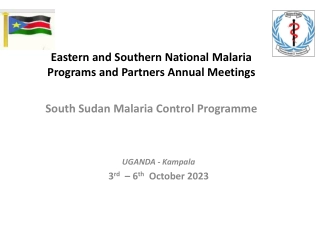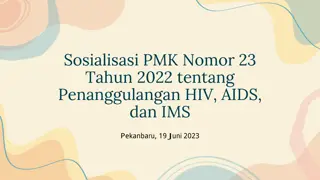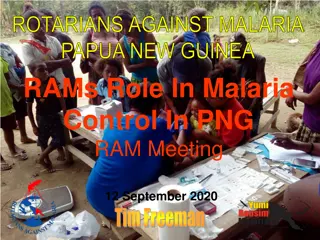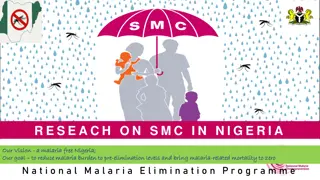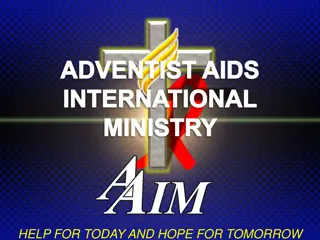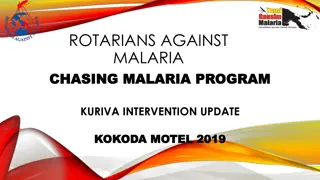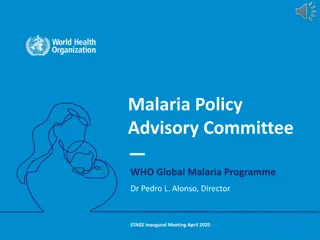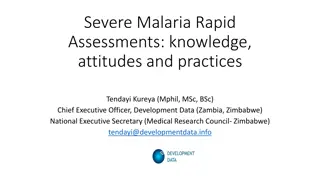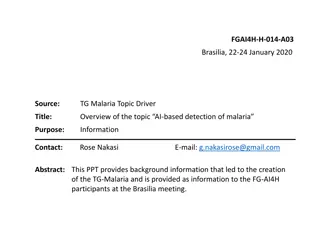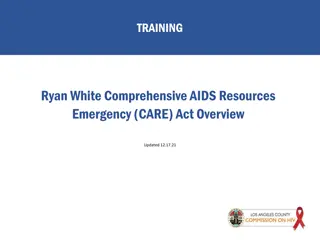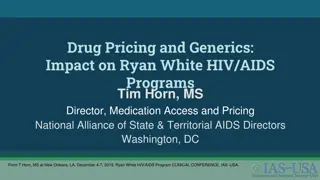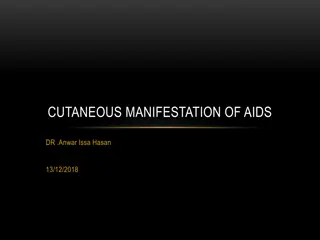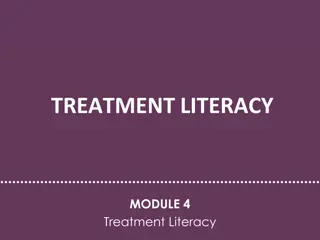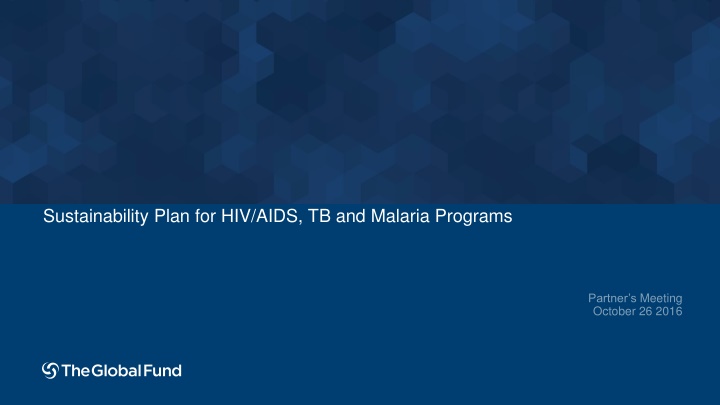
Sustainability Plan for HIV/AIDS, TB and Malaria Programs
This sustainability plan outlines the long-term management capacity for HIV/AIDS, TB, and Malaria programs, focusing on developing ownership and a supportive national environment. It emphasizes the role of domestic financing and external funding to meet the ongoing needs of these health initiatives. The Global Fund appeals for $13 billion from donors over 2017-2019 to cover 80% of the total funding requirement.
Download Presentation

Please find below an Image/Link to download the presentation.
The content on the website is provided AS IS for your information and personal use only. It may not be sold, licensed, or shared on other websites without obtaining consent from the author. If you encounter any issues during the download, it is possible that the publisher has removed the file from their server.
You are allowed to download the files provided on this website for personal or commercial use, subject to the condition that they are used lawfully. All files are the property of their respective owners.
The content on the website is provided AS IS for your information and personal use only. It may not be sold, licensed, or shared on other websites without obtaining consent from the author.
E N D
Presentation Transcript
Sustainability Plan for HIV/AIDS, TB and Malaria Programs Partner s Meeting October 26 2016
THE GLOBAL FUND ASKS DONORS FOR $13 BILLION OVER 2017-2019 Together with strong growth and domestic financing and other external financing at constant levels, 80% of the funding need would be covered US$ (BILLION) 97.5 20.1 13.0 23.4 80% resource need covered 77.4 41.0 Domestic financing Non-Global Fund external financing Global Fund Resource need 1
DOMESTIC FINANCING WILL CONTINUE TO PLAY A KEY ROLE IN MEETING THE FUNDING NEED FOR HIV, TB AND MALARIA US$ (BILLION) Projections build on strong growth reflected in Concept Note commitments. It will be important that governments follow through on these commitments and that all partners continue to catalyze this increase. The Global Fund, through its leveraging ability, will have an important role in this effort. +17% per year 1.3 1.1 0.9 7.5 6.4 5.4 7.1 6.1 5.2 2017 2018 2019 Low income Upper middle income Lower middle income 2
SUSTAINABILITY AND TRANSITION ----------------------------------------------------------------------------------------------------------------------------------------------------------------------------------------------------------------------------------------------------- 3
SUSTAINABILITY AND TRANSITION ----------------------------------------------------------------------------------------------------------------------------------------------------------------------------------------------------------------------------------------------------- 4
Sustainability of HIV/AIDS, TB and Malaria Programs Definition and Assessment Framework Sustainability is the capacity of a country to independently manage their disease- specific programs in the long-term without interruption or compromising quality by developing a sense of ownership and enabled by an adequate internal and external national environment. (TERG) Source: CIF 5
Sustainability Plan Way forward: Description of Services* Through a desk review, determine the scale of external funding of HIV/AIDS, TB and Malaria during fiscal year 2015/2016; Conduct an analysis of the country s economic and political situation particularly as they relate to the three diseases and to health between fiscal year 2010/2011 and fiscal year 2015/2016; Determine the systems governing the management of public funds as they relate to health financing functions and particularly to the three diseases; Assess how HIV/AIDS, Malaria and TB programs are integrated in sustainable health financing; Evaluate prospects of and provide an analysis of programmatic and financial sustainability for the three disease programs between 2016 and 2025 with in the draft national health financing strategy; and Recommend optimal models for a sustainability plan for the three diseases using information collected on public financing management systems, health financing functions and programmatic gaps for the three diseases for the timeframe between 2016 and 2025. NOTE: A National Health Financing Strategy is in the final stages of review by the Government. *Support for the development of a Sustainability Plan for HIV, TB and Malaria for Tanzania through landscape analysis. 6
Example of Zimbabwe Transition program steps Agenda for Sustainable Socio- Economic Transformation Plan (ZimAsset) 2013 2018 Target to Increase Budget Allocation to Health Development of domestic health care financing policy Government put in place legislative provision to ensure that 3% of both individual income tax and corporate income tax is wholly earmarked for HIV responses -> which yielded 24% in co- financing for HIV national response Quality Provisions: Integrated Human Resource Policy (supported by GF) and combined with Health Transition Fund Improved recruitment and retention of health workers in Zimbabwe s public health institutions particularly for doctors and nurses Enhanced quality of health services through out the system 7
Innovative financing mechanisms The Global Fund works with recipient countries to explore alternative funding mechanisms and platforms for domestic resource mobilization for health. Areas of support: Identify and map multiple health financing sources (e.g. financial products, private sector commitments, disease specific tariffs) to fill funding gaps and satisfy future programmatic expenditure requirements; These innovative solutions go hand in hand with investment by the government, the Global Fund and other partners, while attracting a new set of private sector stakeholders, foundations, impact investors and high net worth individuals into the ecosystem of sustainable domestic financing for health. Platforms include: -Social Impact Bonds -Blended Finance platforms -Debt 2 Health Suggest appropriate funding mechanism, structures, and vehicles (e.g. trust funds, remittance savings account, philanthropic contributions &/or impact investments) Support advocacy and public awareness for funding solutions; and Assist in the implementation and roll-out of new sustainable financing mechanisms.
Global Fund Investments in the United Republic of Tanzania Since 2003, the Global Fund to Fight AIDS, TB and Malaria has supported the United Republic of Tanzania through a portfolio of 16 grants (HIV, TB, Malaria and HSS) funding health programs in Tanzania mainland and a separate portfolio in Zanzibar. To date, the signed grants for Tanzania mainland amount to US$ 1.8 billion, of which committed funds represent US$ 1.7 billion and disbursements reaching US$ 1.6 billion. Programs are implemented through both Government institutions in Mainland (Ministry of Finance and Planning as the Principal Recipient and Lead Sub-recipient Ministry of Health, Community Development, Gender, Elderly and Children) and Civil Society Organizations and the through the Ministry of Health in Zanzibar supported by the national programs. The Global Fund principally funds the procurement of health products such as medicines, testing kits, laboratory reagents and long lasting nets. This component constitutes over 80% of the overall funding envelope, with remaining funds supporting investments in improved health infrastructure and service delivery, mainly in human resources for health.
TANZANIA ACTIVE GRANTS Grant Number Disease Grant amount (US$) signed Funds Committed (US$) Funds disbursed to date (US$) 180,334,494 Grant end date PR HIV TZA-H-MOFP 386,605,772 237,727,542 Ministry of Finance and Planning (MOFP) 31 Dec 17 TB TZA-T-MOF 21,377,285 12,562,249 11,914,941 31 Dec 17 Malaria TZA-M-MOFP* 309,086,393 272,587,846 221,458,598 31 Dec 17 HIV TNZ-G06-H (RCCII) 61,192,309 56,113,288 53,846,978 31 Dec 16 Population Services International (PSI) HIV/TB TZA-C-STC 13,059,126 7,798,266 5,753,349 31 Dec 17 Save the Children (STC) *includes funding for Health System Strengthening ZANZIBAR ACTIVE GRANTS Grant Number Disease Grant amount (US$) signed Funds Committed (US$) Funds disbursed to date (US$) 3,062,136 Grant end date PR HIV/TB QNB-C-MOH 10,224,371 4,805,669 Ministry of Health (MOH) 31 Dec 17 Malaria QNB-M-MOH 5,666,833 1,439,792 1,272,952 31 Dec 17
Information on the Next Funding Cycle 1. The Global Fund s Eligibility Policy is designed to ensure available resources are allocated to countries with the highest disease burden and lowest economic capacity, as well as to key and vulnerable populations disproportionately affected by the three diseases. Eligibility is determined by a country s income classification, as measured by Gross National Income (GNI) per capita (World Bank Atlas Method), and official disease burden categorization. http://www.theglobalfund.org/en/fundingmodel/process/eligibility/ Global Fund 2017 Eligibility List 2. http://www.theglobalfund.org/en/applying/updates/2016-09-19_FAQ_on_the_2017-2019_Funding_Cycle/ Frequently Asked Questions on the 2017-2019 Funding Cycle 3. Three (3) submission windows for funding requests in 2017 Window Submission date Technical Review Panel review 1* 20 March 2017 23 April - 02 May 2017 2 23 May 2017 19 June - 28 June 2017 3 28 August 2017 25 September - 04 October 2017 http://www.theglobalfund.org/en/applying/country/registration/ * Please note that applicants applying for program continuation must submit their program continuation request for review in Window 1.
1. The allocation-based funding model remains largely unchanged for the 2017-2019 funding cycle. Eligible countries will receive a communication on their allocation amount in December 2016 and will be able to access new funding over the 2017-2019 period. What is new about the funding model this time? However, elements of the funding model have been amended to align with the new Global Fund Strategy 2017-2022 and new policies. These elements include an updated allocation methodology; new sustainability and transition expectations, including a new co-financing approach; flexibilities for challenging operating environments and differentiation in the way the Global Fund works with countries. 2. In April 2016, the Board of the Global Fund approved the organization s strategy for the period 2017 to 2022, titled Investing to End Epidemics. The strategy is based on a framework of four objectives: 1) Maximize impact against HIV, TB and malaria; 2) Build resilient and sustainable systems for health; 3) Promote and protect human rights and gender equality; 4) Mobilize increased resources. What is the new Global Fund strategy?
What does the increased focus on Resilient and Sustainable Systems for health (RSSH) mean? Lower income countries (LIC) are strongly encouraged to include RSSH interventions in their funding requests Building resilient and sustainable systems for health (formerly referred to as health systems strengthening interventions) are crucial to ensure people have access to effective, efficient, and accessible services through well-functioning and responsive health and community systems. The Global Fund expects each applicant to critically examine their health system and identify areas that need strengthening in order to become more resilient and sustainable and enable effective delivery of disease programs. The revised Eligibility Policy and application focus requirements encourage targeted investments in RSSH in all countries, with broader focus at the lower end of the development continuum* and more targeted focus in areas critical to sustainability at the upper end. Global Fund s new strategy seeks to build resilient and sustainable systems for health by: Investing in strengthened community responses and systems; Supporting programs focused on reproductive, women s, children s, and adolescent health, and platforms for integrated service delivery; Strengthening global and in-country procurement and supply chain systems; Leveraging critical investments in human resources for health; Strengthening data systems for health and countries capacities for analysis and use; Strengthening and aligning to robust national health strategies and national disease specific strategic plans; and Strengthening financial management and oversight. *The development continuum refers to the trajectory of development that occurs in different ways at different speeds in each country. It can include economic, demographic, political and cultural development factors.
How do co-financing requirements relate to the funding request and what has changed? A new co-financing (formerly known as counterpart financing ) policy was approved in April 2016 as part of the new Sustainability, Transition and Co-financing Policy. Its purpose is to incentivize domestic investments in line with national priorities, epidemiological context, and fiscal capacity. A focus on progressively increasing government expenditure on health, particularly in high burden countries with a low prioritization of spending on health and/or low capacity for domestic revenue capture through implementation of robust health financing strategies to meet universal health coverage goals; Requiring all countries to demonstrate the progressive absorption of key program components, such as recurrent human resources, procurement of essential drugs and commodities, and programs that address human rights and gender related barriers and programs for key and vulnerable populations; With its focus on progressive increases in domestic financing, the minimum threshold requirement for co-financing is removed; Requiring engagement with key stakeholders, such as Ministries of Finance, and putting in place mechanisms for annual monitoring of co-financing requirements; A co-financing incentive of not less than 15 percent of the Global Fund allocation for each eligible component will be available to countries upon demonstrated increases in co-financing in priority areas of the disease program and/or related RSSH investments. The requirements to access this incentive depend on a country s economic capacity and disease burden; Greater flexibility to engage on co-financing issues depending on fiscal situation, disease burden, transition requirements, regional and other operating contexts, including challenging operating environments.
Thank you 15

